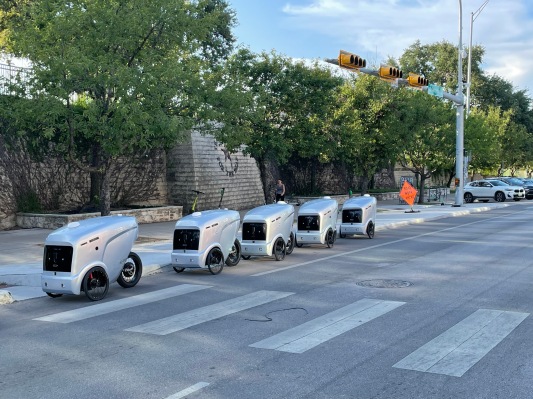When Refraction AI was founded in 2019, its goal was to use robotics to bring down the cost of last-mile delivery. Over the past couple of years, the startup has worked directly with restaurants in its hometown of Ann Arbor, Michigan, to offer its bike-lane bound robots as a logistics layer for customers, rather than trying to be another DoorDash or UberEats.
A little less than a year ago, Refraction moved its commercial operations down to Austin, Texas, where it continued cultivating individual relationships with restaurants. Along the way, the company learned that while offering customers favorable delivery rates was still a priority, Refraction’s real unique selling point is its ability to deliver a higher quality and scalable service.
“You can maybe negotiate great prices with DoorDash, but you can’t make DoorDash give you the A1 quality drivers that do a really good job and are always on time and never make you wait and the food always shows up hot,” Refraction chief technology officer and co-founder Matthew Johnson-Roberson told TechCrunch. “Because you control very little of that, even if you’re a restaurant chain as powerful as Chick-fil-A.”
Chick-fil-A, the fast food restaurant chain specializing in chicken sandwiches with a side of god, said on Tuesday that it enlisted Refraction AI to deploy a fleet of the startup’s self-driving vehicles to two of its restaurants in downtown Austin — at 6th & Congress, where the companies held initial testing, and on Martin Luther King boulevard. The commercial pilot will begin in late June, Refraction said in a statement.
“I don’t speak for [Chick-fil-A], but I get a sense that these experimentations are around trying to fill some gaps that still exist in the current offerings out there on the market that aren’t delivering the level of service they were looking for,” said Johnson-Roberson.
Refraction wouldn’t say exactly how many vehicles it would be delivering for Chick-fil-A, but it’s “an order of 10,” according to Johnson-Roberson.
The deal with Chick-fil-A is part of a larger set of tests Refraction is running to understand how it could serve quick service restaurants by maximizing the profitability and effectiveness of robotic delivery, said Johnson-Roberson. Working with a large chain, rather than individual restaurants, could easily fill up the startup’s fleet capacity for all the robots it has now “and probably other robots we could potentially build in the near to mid-term.”
The company is currently in the process of developing similar partnerships with retail and grocery delivery clients, a spokesperson told TechCrunch.

Refraction AI delivery robot in front of 6th and Congress Chick-fil-A in Austin, Texas. Image Credits: Refraction AI
Refraction’s REV-1 robot is affectionately referred to as the “Goldilocks of robotic delivery” because it’s not too small to only operate on sidewalks and not too big to only operate on streets. The robot was built on a bicycle foundation and as such operates in the bike lane (where they exist, in shoulders where they don’t), traveling at speeds of around 15 miles per hour. This, Johnson-Roberson says, allows the company to increase delivery time while keeping tech costs down — slower speeds than a full-sized autonomous vehicle mean less risk and no need of expensive lidar to see far away.
The robots are largely self-driving with very little human oversight, said Johnson-Roberson. Refraction achieves this by attempting to stick to routes that are easier to drive autonomously. The robots will switch to teleoperated mode, where a remote operator is monitoring and at times controlling the vehicle, only for infrequently used routes or situations that are difficult to address with autonomy, like certain intersections with high risk, unprotected left turns.
“We’re aiming for a very low delivery time,” said Johnson-Roberson, noting that quick delivery is also essential to ensuring food arrives at a reasonable temperature — “10 to 12 minutes.”
The REV-1s have a compartment that is insulated to protect the temperature of the food, but the air from the vehicle’s electronics also vents into the main compartment, which increases the ambient temperature.
“One of the things I didn’t anticipate is the critical nature of the quality of the food delivery experience for big brands,” said Johnson-Roberson. “They live or die by the fact that people think their food shows up and it’s always good and tasty, and it’s repeatable.”
Being repeatable is what will help Refraction keep, and ultimately expand, its relationship with Chick-fil-A, and potentially other larger chains. After all, that’s the MO of restaurant chains everywhere: make it the same, make it good and make it scalable.
Credit: Source link


Comments are closed.